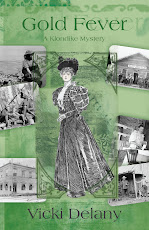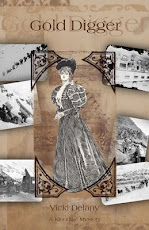


I sometime thought that in later years, if I should be so lucky, the thing I would remember most about Dawson, in this summer of 1898, was the mud. The town had been built with no thought for anything other than access to the gold fields. Inconveniences such as being located on a floodplain, on the flats beside one river and at the mouth of another, right at the spot where the rivers would jam during spring break-up, were inconsequential in light of the town’s desperate need to be at the road to the Creeks where lumps of gold waited to be found.
-Fiona MacGillivray, Gold Fever (Dundurn Press).
Mud.
And a lot of it. Dawson City was built where the Klondike River flows into the Yukon River. A good location for a town, near a waterway, close to the gold fields. But it was also a floodplain. When the ice broke up on the river in May of 1898, the newly arrived townsfolk discovered just what a poor choice of site it was. There are pictures of the Mounties crossing from one building in Fort Herchmer to another in a canoe (sorry can’t find such a picture today, I’ll keep an eye out for it ).
Every tree for miles around had been hacked down for lumber, firewood, and to make room for houses. All that water had nothing stopping it.

The streets were, literally seas of mud. The mud could be as high as a horse’s knees. Duckboards were laid across the streets so people could get across. And mud, as we all know, breeds insects and disease. Never mind what it must have been like trying to keep the floors clean!

GOLD WEB the fourth book in the series, will be released on December 28th. It is now available for pre-order from all your usual sources including Amazon.ca, Amazon.com Chapters.ca And don't forget your favourite independent bookstore. (Pre-orders apply to paperback only. E-books will be available on publication date)



















